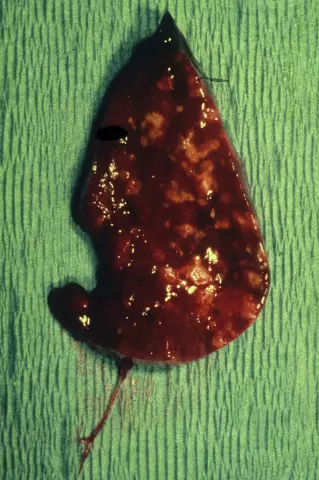- Author Curtis Blomfield [email protected].
- Public 2023-12-16 20:44.
- Last modified 2025-01-23 17:01.
Plague is an infectious disease. This anthroponotic disease affects the lymphatic system, lungs, skin and other organs. It has been known since ancient times and in different centuries during epidemics claimed thousands and even millions of lives.

Plague is a particularly dangerous disease. Its causative agent is a bacterium from the genus Iersinia (Pasteurella) pestis. The plague microbe belongs to the Enterobacteriaceae family. There are various foci of this disease (natural, urban). Under natural conditions, the natural reservoir of pathogenic Yersinia is wild rodents. These are gerbils, ground squirrels, hamsters. In urban areas, the disease is spread by gray, red and black rats. But it is a reservoir of infection. Plague is carried by the common rat flea. Pathogenic microorganisms penetrate into the blood with the faeces of parasites through scratching. The pulmonary form is transmitted from person to person. Basically, infection occurs through direct contact with a living or dead animal or food and household items contaminated with Yersinia. Less common are cases with airborne transmission mechanism.

Directly onno pathological changes were observed at the site of the introduction of plague microbes. Plague is a disease that primarily affects the lymph nodes. Therefore, the entire infectious process will develop there. Small areas of necrosis are formed in the lymph node closest to the site of the entrance gate. This is the result of the action of a strong plague "mouse" toxin on the tissues of the body. Further, the patient develops periadenitis. The affected lymph node - the bubo - increases in size, possibly suppuration, followed by opening.
The development of such a form of infection as pneumonic plague is somewhat different. The disease occurs when pathogenic bacteria are introduced from foci (buboes or skin) with the blood stream into the lungs of a person. As a rule, this is a secondary form that develops against the background of skin or bubonic plague. In this case, the patient develops a complication in the form of a hemorrhagic-necrotic infectious process. Secondary pneumonic plague proceeds like pneumonia.

Perhaps in medicine there are not many diseases more dangerous than the plague. Symptoms of the disease are very specific and depend on the localization of the pathogen. The incubation period is usually no more than 6 days. The disease almost never occurs in a chronic form, it develops at lightning speed. The first sign is acute intoxication. Patients are worried about a severe headache, multiple petechiae are observed. The spleen and cardiovascular system are also affected. The cutaneous form of the disease is very rare. Bubonic plague is much more common. With suchthe clinical form of the disease forms a persistent and extensive inflammation in the lymph node. The so-called buboes are formed. They are very painful on palpation. In the septic form, the formation of not one, but several foci of infection is noted. Plague disease in humans (a photo of the clinical picture can be seen in medical reference books) is characterized by high mortality and the ability to cause outbreaks of epidemics. But it is worth noting that in the last 50 years it has been recorded only in some African countries.






